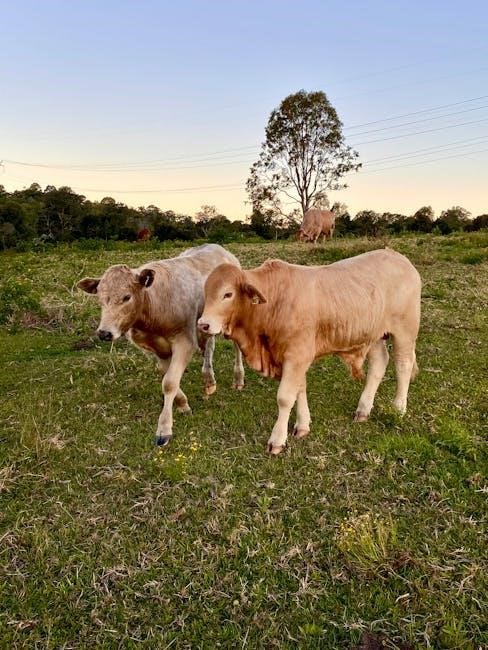
a field guide to the mammals of australia
Australia boasts a unique and diverse array of mammals, many found nowhere else on Earth. A field guide is essential for identifying these creatures, from marsupials to monotremes, in their natural habitats.
Importance of a Field Guide
A field guide to the mammals of Australia is an indispensable tool for anyone interested in the continent’s unique wildlife. With 382 known species, including marsupials, monotremes, and bats, accurate identification can be challenging. A comprehensive guide offers concise details on appearance, diagnostic features, distribution, and habitat, crucial for distinguishing between similar species;
Whether you’re a seasoned biologist, a budding naturalist, or an ecotourist exploring the outback, a field guide enhances your understanding and appreciation of Australian mammals. It aids in research, conservation efforts, and responsible wildlife observation, allowing for informed decision-making and minimizing disturbance to these fascinating animals.
Key Features of a Comprehensive Field Guide
A comprehensive field guide should offer detailed species descriptions, diagnostic features accompanied by illustrations, and information on distribution, habitat, and key behavioral characteristics for accurate identification.
Detailed Species Descriptions
Detailed species descriptions are a cornerstone of any useful field guide. These descriptions must go beyond simple physical characteristics, encompassing a range of information vital for accurate identification in the field. A comprehensive description should include precise measurements of key body parts, such as length, weight, and tail length, providing a quantitative basis for comparison.
Coloration and pelage patterns should be meticulously documented, noting variations between sexes and age groups. Behavioral traits, including activity patterns, social structures, and common vocalizations, add another layer of detail. Habitat preferences, diet, and reproductive strategies should be included, giving context to the animal’s ecological role.
Finally, the description should also highlight any unique or distinguishing features that set the species apart from similar ones, aiding in quick and reliable identification. By combining all these elements, the field guide can provide a truly comprehensive portrait of each mammal species.
Diagnostic Features and Illustrations
Clear and concise illustrations are paramount in a mammal field guide, working in tandem with detailed descriptions. These images should showcase key diagnostic features, allowing for quick visual confirmation of a species’ identity. Illustrations should accurately depict size, shape, and distinctive markings, aiding in differentiating similar-looking mammals.
Beyond general appearance, the illustrations should highlight specific features such as ear shape, tail length, and foot structure, which are crucial for identification. Accompanying the illustrations, concise text should pinpoint the diagnostic features. For example, a note on the presence or absence of a particular marking or the relative size of a body part can significantly aid identification.
Effective field guides often include multiple illustrations of the same species, showing variations in age, sex, or color morphs. By combining high-quality illustrations with clearly labeled diagnostic features, a field guide empowers users to accurately identify mammals in their natural environment.
Distribution Maps and Habitat Information
A crucial component of any comprehensive field guide is accurate distribution maps. These maps visually represent the known geographic range of each mammal species within Australia. The maps should be clear, easy to interpret, and up-to-date, reflecting the latest scientific understanding of species distribution.
Supplementing the maps, detailed habitat information provides context for where a particular mammal is likely to be found. This includes descriptions of preferred vegetation types, climate zones, and altitude ranges. Understanding a species’ habitat preferences is vital for narrowing down identification possibilities in the field.
The field guide should also address any known habitat changes or threats that may be impacting a species’ distribution. This information can be particularly important for conservation efforts and for understanding potential range shifts due to climate change or habitat loss. By combining distribution maps with detailed habitat descriptions, a field guide empowers users to predict where a mammal might be found and to understand its ecological context.

Notable Mammal Groups in Australia
Australia’s mammals are incredibly diverse, featuring unique groups like marsupials (kangaroos, koalas), monotremes (platypus, echidna), and a variety of native bat species, each playing a vital role in the ecosystem.
Marsupials: Kangaroos, Wallabies, and Koalas
Australia is renowned for its diverse marsupial fauna, with kangaroos, wallabies, and koalas being among the most iconic. A field guide is invaluable for distinguishing between the various species of kangaroos and wallabies, which can often be challenging due to their similar appearances. Detailed descriptions, illustrations, and distribution maps are crucial for accurate identification.
The guide should highlight key diagnostic features such as size, color variations, and specific markings. For koalas, the guide can provide insights into their habitat preferences and behavioral traits. Furthermore, understanding the conservation status of these marsupials is essential, as many face threats from habitat loss and other environmental factors. A comprehensive field guide serves not only as an identification tool but also as a resource for promoting awareness and conservation efforts.
Monotremes: Platypus and Echidna
Australia is home to the world’s only monotremes: the platypus and the echidna. These unique egg-laying mammals are a key focus of any Australian mammal field guide. The platypus, with its duck-like bill and webbed feet, requires detailed descriptions of its aquatic adaptations and habitat preferences. Identifying echidnas involves distinguishing between the short-beaked and long-beaked species (though the latter is not found on mainland Australia).
The field guide should include information on their distinct physical characteristics, such as the echidna’s spines and the platypus’s venomous spur (in males). Distribution maps are critical, given their specific habitat requirements. Behavioral insights, including their feeding habits and breeding cycles, further enhance the guide’s value. Conservation notes are also vital, as these extraordinary creatures face ongoing threats. A good field guide is essential for anyone seeking to observe and appreciate these remarkable animals.
Bats of Australia
Australian bats represent a diverse group, with approximately 75 species calling the continent home. A comprehensive field guide must dedicate a significant section to these often-overlooked mammals. Identification can be challenging, requiring attention to subtle differences in wing shape, ear size, and facial features. The guide should feature detailed illustrations and diagnostic keys to aid in differentiating between various bat species.
Echolocation calls, though not directly observable in a field guide, can be referenced to point readers towards acoustic identification resources. Habitat information is crucial, as some bats are forest dwellers, while others prefer caves or urban environments. Distribution maps are essential, especially for species with limited ranges. Furthermore, the guide should address the ecological roles of bats, such as pollination and insect control, and highlight any conservation concerns specific to certain species. A dedicated section on bats significantly enhances the field guide’s overall value.

Using Tracks and Scats for Identification
Beyond direct observation, tracks and scats offer valuable clues to mammal identification. A useful field guide will include a dedicated section on interpreting these signs. Tracks vary greatly depending on the species, substrate, and gait. Illustrations of common track patterns, including size and shape variations, are essential. The guide should detail how to differentiate between similar tracks, such as those of wallabies and kangaroos.
Scat analysis can reveal information about diet and species presence. The guide should provide descriptions of scat morphology, including size, shape, color, and contents. Information on where to search for tracks and scats, such as near water sources or along trails, is also helpful. It is important to note that Barbara Triggs provides all information needed to identify mammals using tracks or other signs they leave behind. This section enhances the field guide’s utility, allowing for identification even when animals are not directly visible.

Authors and Illustrators of Prominent Field Guides
Peter Menkhorst and Frank Knight are renowned for their comprehensive field guides to Australian mammals. Menkhorst’s detailed text, combined with Knight’s beautiful illustrations, makes identification accessible.
Peter Menkhorst and Frank Knight
Peter Menkhorst is widely regarded as the leading authority on Australian mammals, with his field guides becoming essential resources for researchers, enthusiasts, and conservationists alike. His meticulous approach to detailing diagnostic features, distribution, and behavioral characteristics sets a high standard for comprehensive species accounts. He provided detailed text summarizing the appearance, dimensions, habitat and behavior of every species.
Frank Knight’s illustrations are integral to the success of these field guides. His depictions bring each species to life, highlighting key identification markers and capturing the essence of these animals in their natural environments. Beautifully illustrated by Frank Knight. Their combined expertise creates an indispensable tool for anyone seeking to understand and identify Australia’s diverse mammalian fauna.

Where to Purchase Field Guides
Finding the right field guide to Australian mammals is easier than ever, with various options available to suit different preferences and budgets. Physical copies can be found at major bookstores like Boffins Books, which offers a wide selection and Australia-wide shipping. Online retailers such as AbeBooks.com provide access to both new and used copies, including collectible editions.
For those who prefer digital resources, many field guides are also available as eBooks. Check with publishers like CSIRO Publishing for direct downloads. Keep in mind that some older editions may no longer be in print but can still be purchased as eBooks. Always compare prices and check for reviews before making a purchase.